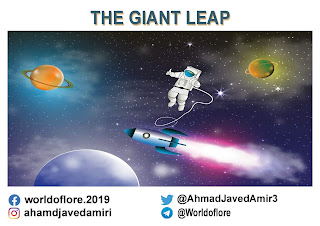THE GIANT LEAP
The
Living Legend
Ahmad
Javed Kamran Amiri
Dated: Wednesday
20th November 2019
It was 20th July, 1969. Millions
of people including men and women in Europe and America sat in front of their
television sets with their eyes fixed on the TV screen. While millions of
others in Asia and Africa gathered round the radio sets listening attentively
to the excited voice of the commentator. Some 3,90,000 kilometers away in
space, two human beings were making history. They were the American astronauts,
Neil Armstrong and Edwin Aldrin Jr., in their Lunar Module slowly descending on
the moon. There are shouts of joy from millions of human beings when the Module
safely landed on the soft and sandy surface of the moon. The name of Neil
Armstrong become immortal when he set foot on the moon. It was just a first and
simple step for a man but a giant leap for mankind. Man had finally established
foothold in space.
By 1940, with
help of powerful telescope, astronomers had collected plenty of data and useful
information about the moon. Meanwhile, writers and poet, with the help of their
imagination, had made journeys to the moon and peopled it with strange and
fanciful creatures. But the main problem for the scientists was how to reach
it.
The answer came
with the invention of V-2 rockets by Germany in 1942 during the Second World
War. The V-2 rocket was perhaps the greatest invention in the field of
technology which made space exploration possible. The basic principles, design
and components of the V-2 are at the heart of all space vehicles being used
than. With a vehicle in the form of V-2 rocket, space travel become a
possibility. But the speed of this rocket was only 7,200 kilometers per hour. To
remain in orbit close to the earth, a satellite had to travel at 29,000
kilometers per hour. To escape from the earth’s gravity completely, a speed of
40,000 kilometers per hour had to be achieved. After several years of research
and experiments, space scientists developed multi-stage rockets in which
rockets are mounted one on the top off another. Each rocket adds its force to
the one above it and then drops off so that very high speed is achieved by the
last one in the series.
The ‘space race’ between the U.S.A. and the U.S.S.R. began with the
launching of Sputnik I (1) by Russia in October 1957, followed a month later by
Sputnik II (2) carrying the dog Laika. The world was startled. America also
joined the race six months later by launching Vanguard in March 1958, the first
of a long series of satellites. NASA, the National Aeronautics and
Space Administration, was set up in 1958. It organized a ‘man-in-space
program’ for which the first seven astronauts were selected.
The Russians once
again surprised the world when the launched their first manned spacecraft
Vostok I (1) in April 1961. It carried Yuri Gagarin, the first man in space. The
Americans launched their first man Alan Shepard in Freedom 7 Capsule in May
1961. The Russians also sent the first woman astronaut, Valentina Tereshkove,
in Vosrok VI (6) in June 1963.
The NASA planned
the lunar program, called Project Apollo, for putting Americans on the moon.
after and expenditure of about 7,000 million dollars, the labor of about
300,000 technicians and workers, the research and experiments of thousands of
scientists, designers, engineers and technologists, and the co-operation of
about 20,000 manufacturing companies, Apollo II (2) was ready for take-off on
Cape Kennedy launching pad on the 16th July 1969. In the Capsule at
the top of the 110.64 meter spacecraft were three astronauts, Neil Armstrong,
Edwin Aldrin and Michael Collins. At 09:30 AM of American time it rose with a
thunderous noise from the launching-pad and began its historic journey to put
the first man on the moon.
THE GIANT LEAP
 Reviewed by World of Lore
on
November 19, 2019
Rating:
Reviewed by World of Lore
on
November 19, 2019
Rating:
 Reviewed by World of Lore
on
November 19, 2019
Rating:
Reviewed by World of Lore
on
November 19, 2019
Rating:









No comments: